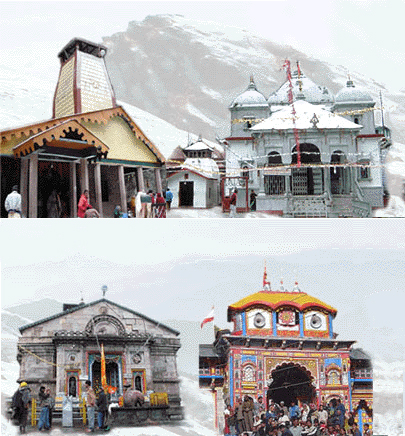

Vedic literature describes a transcendental group of holy sites nestled in the Garhwal (Middle) Himalayas, which have drawn pilgrims since time immemorial. Collectively known as the Char-dham, or four sacred spots, they include Badrinath, Kedarnath, Yamunotri, and Gangotri. In this series, we will explore the holy Char-dhama and the sacred waters around which they manifested.
Going on pilgrimage to the Char-dham sites will cleanse the surrendered seeker of the accumulated contamination of material life and release the jivatma from the repeated cycle of birth and death. According to the Puranas, every Hindu must undertake this journey once in his lifetime. To be born or to die here is considered beyond auspicious.
The journey to these holy dhamas is arduous, particularly for children and the elderly. Although buried under snow for a significant part of the year, still persons of all ages come, undeterred in their search for union with the Supreme Personality of Godhead.
As their names imply, Gangotri and Yamunotri are dedicated to the holiest rivers in Mother Bharat, the Ganga and the Yamuna. Each of the four dhamas receives holy water: the Yamuna in Yamunotri, the Bhagirathi in Gangotri, the Mandakini in Kedarnath, and the Alaknanda in Badrinath. Badrinath is the seat of Lord Vishnu, while Kedarnath is the seat of Lord Shiva.
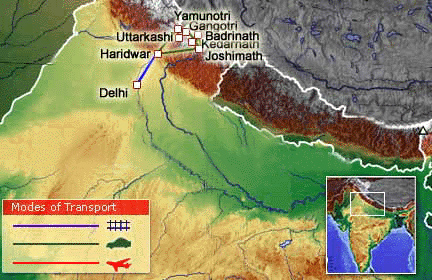
The pilgrims journey around Char-dham begins from the western side, with the shrine of Yamunotri, then proceeds on to Gangotri, Kedarnath and finally Badrinath. This pathway follows the proper Vedic route for parikrama, in a clockwise direction.
Beautiful views of snow capped mountains, bright meadows, green landscapes and refreshing springs can be seen all along the dhama route. Pilgrims find numerous places along the way to take bath in both hot and cold springs.
A host of other spiritual destinations are found all around the char-dhama route and a short distance away. Pilgrims visit as many as possible along the way, including Haridwar, Barkot, Uttarkashi, Guptakashi, and Joshimath. Among the numerous configurations of holy sites and shrines, three are particularly important: the Panch Kedar, the Panch Badris, and the Panch Prayag.
At Bridha Badri, or the 'old Badri', Badrinath was worshipped here by Shankaracharya. The temple complex at Adi Badri is comprised of 16 small temples with intricate carvings. Seven of these temples belong to the late Gupta period, and they are ascribed to Shankaracharya. The main temple is home to a black stone Deity of Vishnu.
Rudra-prayag, named for Lord Shiva is situated at the confluence of Alaknanda and Mandakini Rivers. In order to master the mysteries of music, the sage Narada worshipped Lord Shiva, who appeared in his Rudra incarnation here to bless the sage. Also at this place, Sati was reborn after her self-immolation. In her new life as the daughter of Himalaya, she did penance here to ask the boon of Shiva as a husband again.
The icy waters of the Pindari Glacier becomes the Pindari River, and where it meets the Alaknanda River, the confluence is known as Karna-prayag. The name is derived from Karna, the son of the Queen Kunti and Lord Surya. Ganga and Shiva also appeared here to Karna in person.
Nand-prayag marks the confluence of the Alaknanda and Mandakini rivers. The confluence is named for the pious Raja Nanda, who performed Maha Yagna here. The slab on which the Yagna was performed is the foundation stone for the Nand temple.
The Visnu-prayag is formed by the confluence of the Vishnu Ganaga (known after this point as the Alaknanda) and the Dhauliganga River. The Vishnu kund temple is here, where Narada worshipped Lord Vishnu after incurring the wrath of Brahma, which led to his birth in human form.
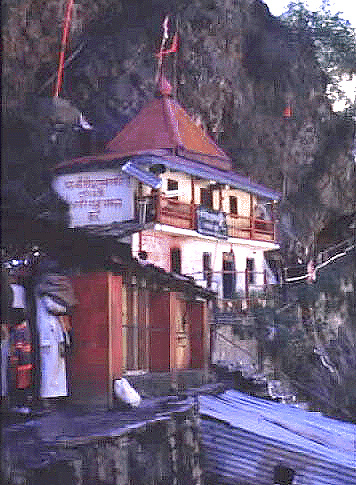
The sacred shrine of Gangotri dhama is the first of the four Char-dhamas to be visited on pilgrimage. Located 99 kilometres form Uttarkashi, it is situated at an altitude of 10,500 ft. and marks the source of the River Bhagirathi. The site is surrounded by mountain peaks known as Shivlinga, Satopanth and the Bhagirathi sisters.
According to sastra, the heavenly Goddess Ganga manifested herself in the form of a river to absolve the sins of King Sagar's sons. After three generations of severe penance, performed over hundreds of years, Ganga Ma conceded to descend to the Earth. Here, at the sacred source of the river, Goddess Ganga is worshipped in her Deity form.
The persistence and austerities performed by King Bhagirath, who was the great-great-grandson of King Sagar, play a central role in the manifestation of the Ganga here. King Sagar had 60,000 sons who were burned to ash by the sage Kapila after they had erroneously accused him of being a thief. Kapila later advised Amshuman, King Sagar's grandson, that only by bringing the Ganges down from the heavens could peace be properly restored.
Amshuman and his son Dilip both tried unsuccessfully to follow Kapila's instructions. Dilip's son, Bhagirath, eventually retired to Gangotri to perform great austerities finally the demigods agreed to send Ganga to earth. Next Bhagirath appealed to Lord Shiva to allow Ganga Ma, in the form of the Ganges waters, fall on his head, since its force would otherwise destroy the earth planet. Once Ganga touched earth, Bhagirath led her out of the mountains and to the sea, where she touched his ancestors' ashes and finally washed away the sinful reactions.
In its journey to the sea, the Ganges River travels some 2,500 kms across the Indian subcontinent, blessing the people of India and Bangladesh with life-giving water. The Sunderban delta in Bangladesh is now the world's largest and most fertile delta.
While Gangotri is the place of worship associated with the source of the Ganges, the actual source is understood to be the glacier at Gaumukh, which is 12 miles upstream.
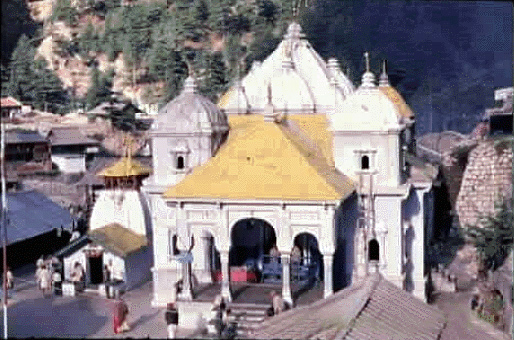
The current temple dedicated to Ganga Ma was built about 250 years ago by the Gurkha monarch, Amar Singh Thapa. The structure was then restored in the late 19th century. The temple is open for pilgrims from October to May. During the winter months, when the area is covered by deep snow, Ganga Ma retreats to Mukhba, 12 kilometres downstream, where she is worshipped.
The main temple complex at Gangotri is made of white granite and is twenty feet tall. Close to the temple is a stone known to be the Bhaigirath shila, which marks the place where Bhagiratha meditated and did penance to encourage Mother Ganga to earth.
At Gangotri temple, a railing is placed across the sanctum to prevent entrance into the main temple area. Each morning and evening, the Ganga Ma's Deity is brought out to give darshan to all the pilgrims.
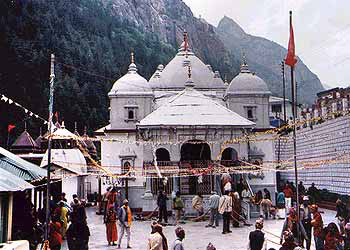
Up until 1987, pilgrimage had to cross a dangerously swaying rope that enabled them to cross the Ganga's raging torrents, and get to the dhama grounds. Many lost their lives to the water here. Eventually a bridge was put in place, making it easier and safer to cross.
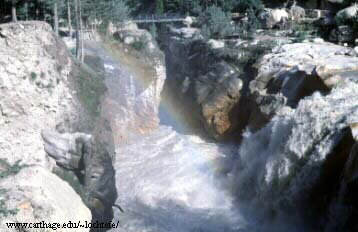
Near the Gangotri temple is a smaller temple dedicated to Lord Shiva. Built in the Nagara architectural style, it has a high tower prominently featured overtop the Deity. Also submerged in the waters by the temple is a Shivling that is visible in early winter, when the water level is lowest. Devotees understand this to represent the place where Ganga flowed into Shiva's hair.
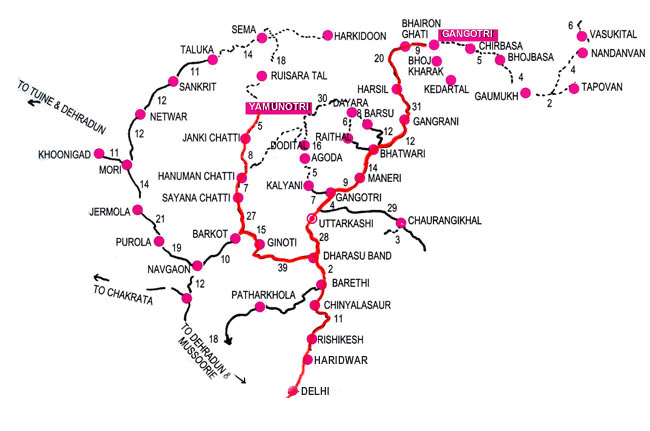
Pilgrims traveling to Gangotri char-dhama also visit holy sites around the base of the glacier. Harsil, Vasuki tal, Sattal, and Nandanvan are nearby. In Uttarkashi, 99 kms. from Gangotri, are found the Vishwanath temple, Ekadash Rudra temple, Gyaneshwar temple and Kuteti Devi temple. Dayayra Bugyal, about 93 kilometres from Gangotri, is the home of a famous Sheshnaga temple.
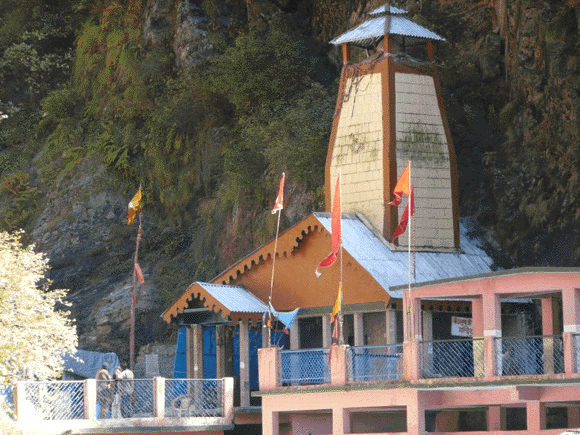
Following yesterday's publication of the Char-dhama, we realized that contrary to our intention to present the dhamas in the order one would visit them on pilgrimage, we reversed the order of Yamunotri and Gangotri, presenting Gangotri first. An attentive reader pointed out that the opening image was for Yamunotri, not Gangotri (due to our reversal of the order), and that the Shivlinga, Satopanth and Bhagirathi sisters are upstream from Gangotri, at Gaumukh. In addition, the writer points out that the story of King Sagar presented in yesterday's article is commonly found in the Puranas, but that the Srimad-Bhagavatam states the following:
Srimad-Bhagavatam 9.8.11:
"By the influence of Indra, the King of heaven, the sons of Sagara had lost their intelligence and disrespected a great personality. Consequently, fire emanated from their own bodies, and they were immediately burned to ashes." Purport by Srila Prabhupada: "The material body is a combination of earth, water, fire, air and ether. There is already fire within the body, and our practical experience is that the heat of this fire sometimes increases and sometimes decreases. The fire within the bodies of the sons of Sagara Maharaja became so much hotter that all of them burned to ashes. The fire's increased heat was due to their misbehavior toward a great personality. Such misbehavior is called mahad-vyatikrama. They were killed by the fire of their own bodies because of insulting a great personality."
Our thanks to Jaya Vijaya prabhu of Padayatra-India for this contribution.
Beginning the Char-dhama yatra from the proper position, one starts at the western-most shrine of Yamunotri in the Garhwal Himalayas. Situated near the Yamuna River, in the area of three hot sulphur springs, the Yamunotir temple was built on a flank of the Bandar Poonch peak, approximately 10,600 feet above sea level. Where the road splits at Dharasu, Yamunotri sits opposite to Gangotri. The temple stands on the foothills of Kalinda Parvata, close to the thermal springs. The region is very close to the Indo-Chinese border and is surrounded on all sides by the Himalayan range.
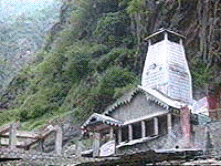
Yamunotri is known as the source of the sacred River Yamuna, which actually originates from the Champasar Glacier, lying upstream of the shrine at an altitude of about 14,200 ft. While pilgrims flock to the Yamunotri temple site, few make the arduous journey to the source at Champasar, at Saptrishi Kund. For those who can make the journey, however, Saptrishi Kund is much loved for its dark blue waters, slate stones, and a rare variety of lotus adorning the kund waters.
Surya, the sun god, is the father of Yamuna and her brother Yama, the god of death. Therefore anyone who bathes in the River Yamuna is said to get special benediction from Yama at the time of death. Yamunotri dhama is also said to have been the home of the sage, Asit Muni.
The temple was originally built in 1839 by Tehri Naresh Sudarshan Shah, then re-built in the 19th century by Maharani Gularia of Jaipur after deteriorating with time, weather, and earthquake damage. Temple rituals and offerings are made to a Deity of the Goddess Yamuna, carved in black stone. Temple rituals are overseen by the Uniyal family of pujaris. Before entering the temple, devotees offer worship to Divya Shila, at the shrine's entrance.
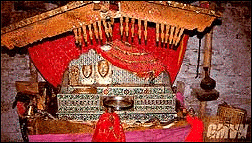
Of the numerous hot water springs around the temple, Surya Kund is considered the most sacred. Pilgrims cook rice and potatoes in the hot water of these springs, wrapping them in a piece of cloth and dipping them in the kund for a short time. The bhoga is offered to the presiding Deity, Yamuna Ma, then distributed as maha-prasad.
The trek to up to Yamunotri is spectacular, and large numbers of pilgrims traverse the rugged peaks and forests to get there from May to October. To get to the temple, one makes a six km. walk from the town of Hanuman Chatti, then a four km. walk from Janki Chatti. Some pay to ride horses or be ported along in palanquins or kandis. Hanuman Chatti is located at the confluence of the rivers Hanuman, Ganga, and Yamuna. It is also the starting point of the trek to Dodi Tal.
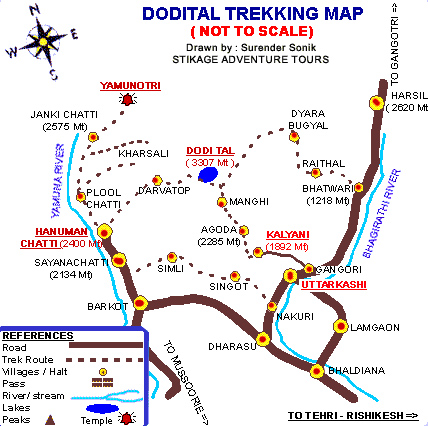
Arriving in Janki Chatti, three km. from Yamunotri, many pilgrims take bath in the hot springs before completing the trip to the temple site.
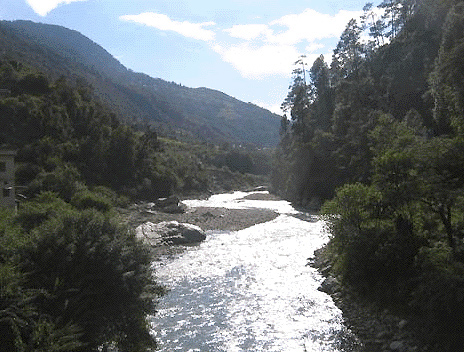
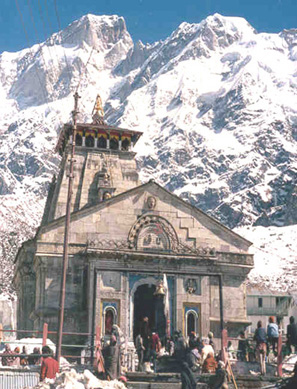
The third stop on our Char-dhama pilgrimage is the holy site of Kedarnath, which marks one of the twelve Jyotirlingas of Lord Siva. Framed by magnificent Himalayan peaks on the Kedarnath range, the ancient temple of Kedarnath sits 11,700 feet above sea level. This region of the Himalayas is also known as Gandhamadana parvatham and Sumera parvatham.
The term Kedara denotes Lord Siva in his aspect as the one who holds the holy Ganges in his matted locks and allows it to flow evenly to the world. It also refers to the mark left on Lord Shiva's head from the time when Arjuna got the Paasupathastram.
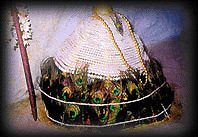 Situated at the head of the Mandakini River, Kedarnath is considered one of the holiest places of pilgrimage in all of India. As described in sastra, when Lord Shiva wished to elude the Pandavas, he took refuge in Kedarnath, in the form of a bull. Finding a herd of cattle grazing in the marshy Kedar, he turned himself into a bull and mingled with the herd. The Pandavas were at a loss to find him, until Narada Muni suggested that Bhima stand with his feet on two adjoining mountains. The other four Pandavas could then round-up the cattle and drive them through Bhima's legs. Narada, of course, realized that all the cattle would pass under Bhima's legs except the bull who was Shiva in disguise. Thus when the Pandavas found a solitary bull refusing to follow the herd, they ran after and corralled him. Shiva then began digging the soft earth so as to descend and escape. Bhima caught hold of the bull's hump, and in exchange for their great perseverance, Shiva relented and give darshan to the Pandavas before disappearing underground.
Situated at the head of the Mandakini River, Kedarnath is considered one of the holiest places of pilgrimage in all of India. As described in sastra, when Lord Shiva wished to elude the Pandavas, he took refuge in Kedarnath, in the form of a bull. Finding a herd of cattle grazing in the marshy Kedar, he turned himself into a bull and mingled with the herd. The Pandavas were at a loss to find him, until Narada Muni suggested that Bhima stand with his feet on two adjoining mountains. The other four Pandavas could then round-up the cattle and drive them through Bhima's legs. Narada, of course, realized that all the cattle would pass under Bhima's legs except the bull who was Shiva in disguise. Thus when the Pandavas found a solitary bull refusing to follow the herd, they ran after and corralled him. Shiva then began digging the soft earth so as to descend and escape. Bhima caught hold of the bull's hump, and in exchange for their great perseverance, Shiva relented and give darshan to the Pandavas before disappearing underground.
After Shiva dived into the ground, he left behind his hump of the surface. Kedarnath (the hump) is therefore known as one of the Panch Kedar, being joined by sacred sites representing Shiva's arms (bahu) at Tungnath, face (mukh) at Rudranath, navel (nabhi) at Madmaheshwar, and hair (jata) at Kalpeshwar. The hump is worshipped in the temple at Kedarnath in a conical Shiva pinda form, while the remaining parts of the body are worshipped at the other four locations.
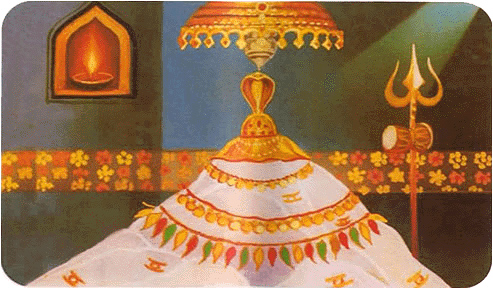
While the Pandavas pursued Lord Shiva, the mountain path they traveled along is known as Sorga Vaasal. Sankaracharyara is understood to have also traveled along this route. The present temple at Kedarnath was built by Adi Guru Shankaracharya in the 8th century, and it is adjacent to the site where the Pandavas had once built a temple 5,000 years ago. To this day, Shankaracharya's devotees serve as the temple functionaries, with a Nambudiripad Brahmin from Kerala as the chief priest/Rawal.
The ancient temple at Kedarnath has been renovated many times over the centuries. The current temple is a formidable structure, planted in the middle of a plateau with snow covered peaks of the Himalayas framing it. The temple architecture is exquisite, the outside being relatively unadorned with ornament, while the inside is richly embellished with lila scenes and figures. At the entrance to the sanctum sanctorum is a statue of Nandi, Lord Shiva's vahana bull. The temple interiors are filled with many exquisite carvings. In the garba griha is the conically-shaped Jyotirlingam, believed to be the actual hump of the bull whose form Shiva assumed. Devotees pass through a small archway and up a short flight of stairs to reach the Deity, which they lovingly embrace in the mood of Bhima.
The sannadhi or main altar of Lord Shiva faces South. Deities of Lord Krishna, Kedaragowri, the Pancha Pandavas, Draupadi, Vinayagar, Veerabadrar, Kaarthikeyan, Parvati, Lakshmi, Narada, and Nandi are nearby. Outside, at the northeast corner is a small temple of Ishaneshwar Mahadev.
Just behind the temple, on the banks of the Mandakini, is found the samadhi of Adi Guru Shankaracharya, who took samadhi at the early age of 32, after establishing the four pilgrimages, or Char-dhamas. A small temple with his murti form and a Shivalinga are worshipped there. Between the samadhi and the main temple is a patch of bright greenery. The two temples are divided by a marble wall, and resting on the wall is a murti form of Shankara's hand holding his danda.
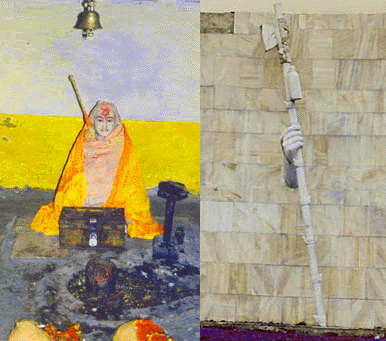
Six months of the year the temple is covered in snow, and it is closed to pilgrims between Oct/Nov, opening again for Akshay Tritiya in April. During the period when no pilgrims visit, it is understood that the Devas are on site, worshipping the Deity.
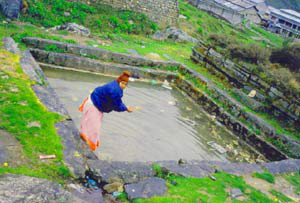
There are several natural springs or kunds in the area. One, within the temple quadrangle, is known as Brahma Kund. At the front of the temple, along the main road, is the Udak Kund. To the right of the main temple is Hamsa Kund.
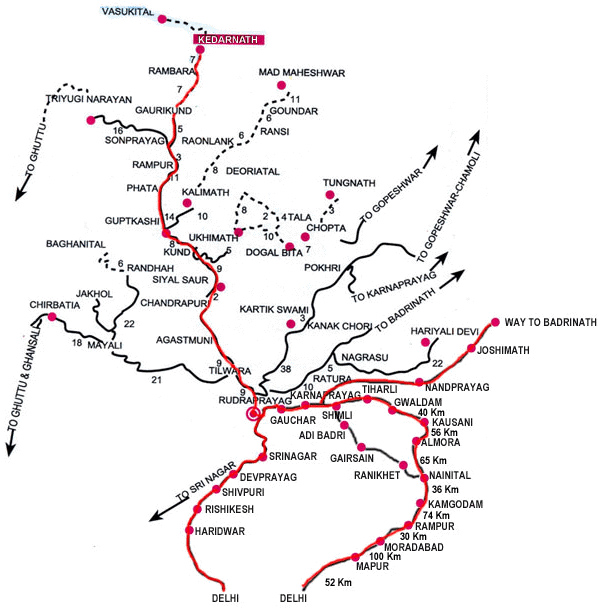
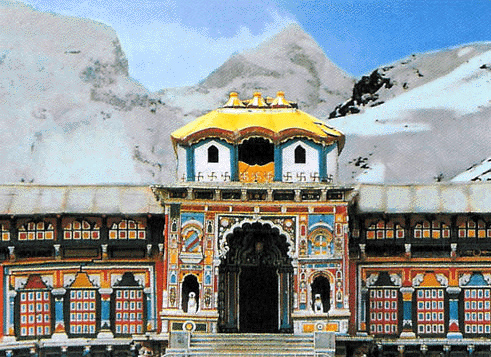
The final stop on our Char-dhama pilgrimage is the transcendental abode of Badrinath, home of the Lord in His Visnu form of Badri-Narayana. Leaving Kedarnath, the third stop on the Char-dhama route, one retreat South to Rudra Prayag, turning north once again to the sacred confluence of Karna Prayag. Here the Alakananda River meets the Pindar River, coming down from the Pindar glacier. Traveling relatively due north, one arrives at Badrinath dhama, which is situated in a valley of the Nara-Narayan Parvat, In the background is the imposing Neelkanth, a Himalayan peak rising 21,000 feet above sea level. Badrinath itself is situation at approximately 10,350 ft. There, in a wide valley carved out by the headwaters of Alakananda River, the largest tributary of the Ganges, is one of the most famous mountain passes leading from India to Tibet.
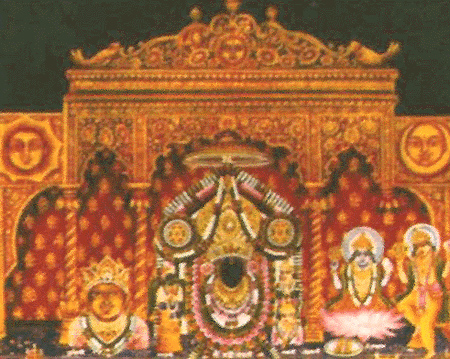
The presiding Deity at Badrinath dhama is a Salagram form of Lord Vishnu, seated in padmasana (lotus pose). Lord Badri-Narayan's abode is protected by two mountain ranges, the Nar and the Narayan. The place is called Badrinath because it was once carpeted in wild berries (badris).
The Badrinath temple is visited by countless numbers of pilgrims each year, who wait for the snows to melt and give them access. Even so, it is a difficult journey, as are the other dhamas on the Char-dhama route. The temple stands facing the Alakananda River. Devotees stop to take bath at the nearby Tapt Kund, a thermal spring, before going to the temple.
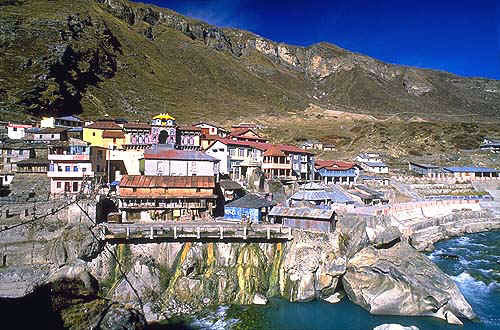
As described in sastra, Lord Vishnu was reprimanded by Narada for indulging in worldly pleasures, and came here to Badri-van to perform austerities. The River Alakananda was created when Ganga Ma was requested to descend to the earth. Lord Shiva took her flow onto his head, down the locks of his hair, so the earth planet could withstand the force. River Alakananda is one of the streams from that water flow.
About Badrinath, the Skanda Purana says: "There are several sacred places of worship in heaven, on earth, and in the hell; but there is no one of them like Badrinath." Here, the sages Nara-Narayana performed austerities. Krishna's dear friend Uddhava visited 5,000 years ago, and it was been visited by many saints over the ages, including Gautama Rishi, Kapila, Kasyapa, Ramanujacharya, and Madhvacharya.
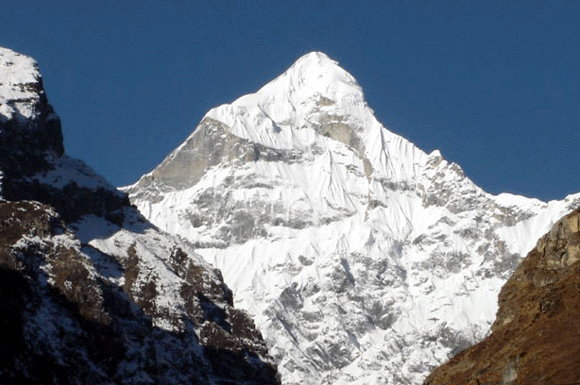
Like Kedarnath, the main temple at Badrinath has been built and re-built many times due to aging, storms and avalanches. It was established in the 8th century by Adi Shankaracharya, but the present structure was built just three centuries ago by the Garhwal kings. It stands five metres and features a conical top with a small cupola of gilt bull and spire. As one can see from the many available photos, the temple façade has been re-painted many times, in different color combinations.
It is generally accepted that prior to the time of Shankaracharya, the temple was a Buddhist site. Local residents say that the Tibetans would cross over the Mana pass each fall for the temple's closing, and would bring a woolen robe to drape around the Deity before moving Him to new quarters.
In the garbha griha, or innter sanctum, where Lord Badri-narayan resides, there is a darshan mandap for puja and a sabha mandap for devotees to assemble. Fifteen black stone Deities also reside there, including Lakshmi, Garuda, Lord Shiva, Parvati, and Ganesha. As usual, a group of hereditary pandas (priests) serve as temple functionaries, and offer Lakshmi-Narayan puja at Badrinath. They also serve as local guides and offer various resources to pilgrims.
Nearby the main temple there is a place called Charanpaduka, where a large boulder bears the actual footprints of Lord Vishnu, imprinted in the rock when He descended from Vaikuntha. Devotees make offerings of pada-seva at this site.
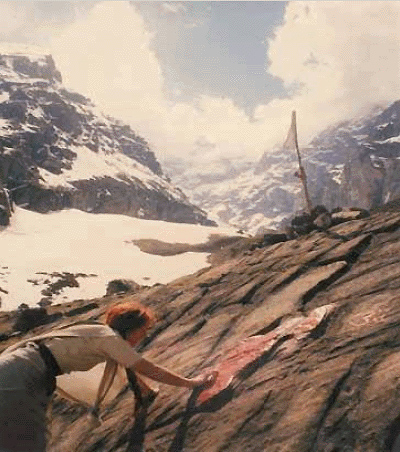
Badrinath-dhama also serves as the summer meeting place of the Shankaracharyas, whose leader established a monastery here, as well as at Puri, Dvaraka, Udipi, and Joshimath (where the Deity of Badrinath spends the winter). There is a building here that houses the Shankaracarya's office as well as a public restaurant.
Four other temples or 'badris' are found near the main Badrinath temple, and together they form the Panch Badri. Located just a few kilometres from the Badrinath temple are Yog Dhyan Badri, where the Pandavas handed over their empire to King Pariksit before retiring, along with Bhavishtya Badri, Adi Badri, and Vriddha Badri.
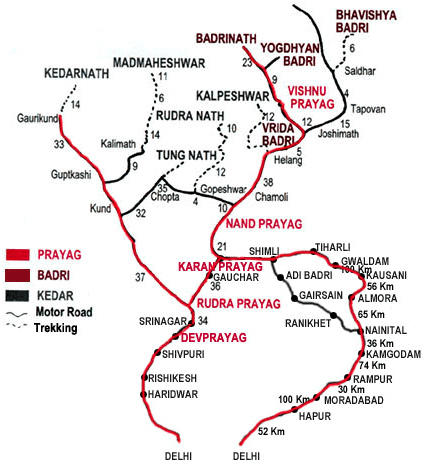
![[BVML Home Page]](../grfx/bml_logo.gif)